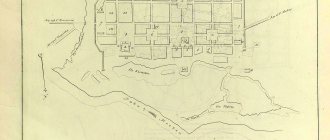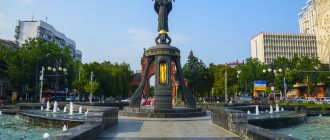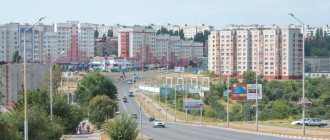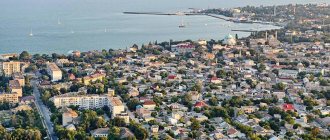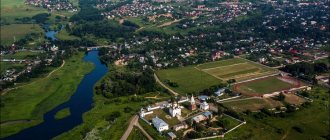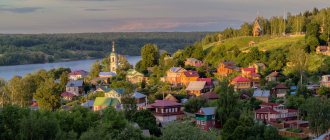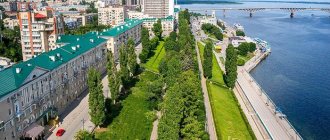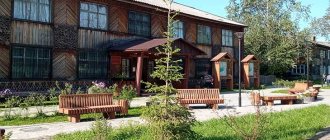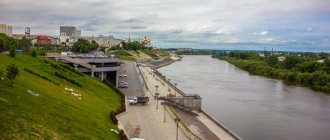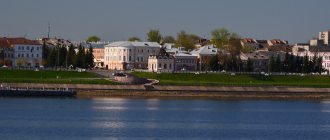Not on every map of Russia you can find little Tarusa. The sights of this city in the Kaluga region, however, are in demand - it plays an important role in the history and culture of Russia. Tarusa is named after a small river - in the places where the river merges with the Oka, and the center of the appanage principality was once located. The first mentions of it are found in chronicles dating back to 1246. More than 30 monuments of historical and archaeological value have been found on the lands of the modern city and in the surrounding area.
Brief description of Tarusa
Tarusa is a small Russian town located in the Kaluga region (on the left bank of the Oka) . The total area of the city is 12 km2, and the population is about 9,300 people. There is no railway in Tarusa, so the city has not undergone much industrialization. In the suburbs of Tarusa there are still large deposits of expanded clay, building limestone and other rocks suitable for construction. Most of the houses in the city are one-story or two-story, and the city itself seems quiet and cozy, so tourists see here a truly Russian outback.
The city of Tarusa is located northeast of Kaluga
Brief history of the city
The first mention of Tarusa dates back to 1246 - at that time the city was the center of the appanage domain of Prince Yuri. The prince's descendants ruled here until 1392. After this, the patrimony joined the Moscow Principality. In 1472, the Horde army tried to capture Oka, but Russian troops repelled the attack, and after the battle this land passed to Ivan III’s brother, Andrei the Menshoy.
The city was repeatedly attacked by the Crimean Tatars, but due to the strategic importance of the Oka, Tarusa was well fortified, and all attacks were easily repulsed. Due to the plague epidemic at the end of the 17th century, only 20 residential buildings remained in the settlement. All this led to decline in all areas. The fortifications were abandoned, and in 1760 their remains were finally washed away by the river.
At different times, Tarusa belonged to the Moscow province and Serpukhov, and it became a district of the Kaluga province in 1796. Now it is an independent city in the Kaluga region, which is valued by tourists not only because of its history. Tarusa is the birthplace of many creative people who have made a huge contribution to the development of Russian culture.
There is no specific theory about the origin of the city's name, but there are several legends. According to one of them, Prince Svyatoslav Igorevich went on a campaign (964) against the Khazars by water and saw a village on the banks of the Oka. From the ship he asked what kind of settlement this was, and the people on the shore answered: “That’s Rus'!” The Grand Duke remembered the name, and it was adopted by his descendants. It is believed that the name Tarusa was previously written with an “o”.
The close proximity to the Oka River played a decisive role in the history of Tarusa
Tarusa embroidery
We specifically went to Nerezova Street to buy products from the Tarusa embroidery factory. It's hard to walk. The road climbs steeply uphill and at the same time turns sharply. So that leaving cars are not visible.
Tarusa embroidery is the same folk brand as Vologda lace and Palekh painting. During the Soviet years, they became concerned about saving the style of embroidery characteristic of the Kaluga lands, and created the Tarusa artel. Now production can be said to be dying. Many people know about Zhostovo trays or Palekh boxes, but only a few know about Tarusa embroidery. Following a tip from the guide, we came to the store at the factory. The assortment, I must say, is meager. Here you can buy linen items. But there's not much to choose from. Personally, either the color, or the size, or the price did not suit me. I don’t think it’s necessary to pay 6,000 rubles for a linen shirt, even with handmade lace, and I certainly won’t need a linen robe a la kimono. Well, it's not mine. As well as a dress in the style of the Soviet film “Hearts of Four”.
In the end, I took a napkin with the embroidered name of the city “Tarusa” for 350 rubles. And this is the lowest cost of the product in the store. Other napkins, with different embroidery or different colors, cost from 600 rubles. But next to the factory building a two-story souvenir shop is being built. The design itself is very interesting. And the fact that this house has two floors suggests an expansion of the range, and therefore an optimistic future.
Sights of Tarusa
Despite the modest size of the city, there are many attractions:
- architectural;
- cultural;
- historical;
- natural.
Architectural landmarks
The most striking architectural monuments of Tarusa are:
- Cathedral of the Holy Apostles Peter and Paul;
- Church of the Resurrection of Christ;
- monument to Paustovsky;
- house of Svyatoslav Richter.
Cathedral of the Holy Apostles Paul and Peter
The Cathedral of the Holy Apostles Paul and Peter was built in 1789 at the expense of Catherine II. The temple was erected on the site of the former St. Nicholas Cathedral, which burned down in 1779. The beautiful whitewashed church is notable for its three-tiered bell tower (built in 2005); this striking architectural design is depicted on city postcards and guidebooks. The architect of the project is considered to be I. D. Yasnygina.
The young Archimandrite Seraphim, the future Bishop of Tomsk, was appointed rector of the church in 1930 (and served until 1933).
Schedule of services:
- Monday - 17:00 (all-night vigil);
- Tuesday - 8:00 (confession), 9:00 (liturgy);
- Wednesday - 8:00 (confession), 9:00 (liturgy), 17:00 (all-night vigil);
- Thursday - 8:00 (confession), 9:30 (liturgy), 17:00 (all-night vigil);
- Friday - 8:00 (confession), 9:00 (liturgy), 17:00 (evening service);
- Saturday - 8:00 (confession), 9:30 (liturgy), 17:00 (all-night vigil);
- Sunday - 8:00 (confession), 9:00 (liturgy).
The Cathedral of Peter and Paul is located at Lenin Street, 1 “B”.
Church of the Resurrection of Christ
The Church of the Resurrection of Christ (Resurrection Church) was built in 1654. Initially, it was a pillarless quadrangle, built next to the Orthodox cemetery, but the church was rebuilt in 1900, and in Soviet times the cemetery was destroyed. After reconstruction, the temple began to look different: larger and more majestic.
Previously, the church had a side chapel of the Tarusa Bogolyubskaya Icon. The icon of the Mother of God is considered miraculous. Tarussians believe that she saved the townspeople from cholera in 1848 and 1871. To save themselves from the terrible epidemic, the Orthodox residents of the city held a religious procession on the day of remembrance of the icon and on the feast of the Dormition of the Blessed Virgin Mary.
After restoration, the decoration of the temple was carried out with the participation of the artist, icon painter and icon restorer I. V. Vatagina.
The church is located on Efremova Street, 13 “A”, the parish is on Efremova Street, 7 (it is open on Saturdays and Sundays from 8 am to 4 pm) .
Monument to Paustovsky
The monument to Paustovsky was erected in 2012. Tarussians consider Paustovsky their fellow countryman, are proud of this and respect the work of the famous writer. The date of installation of the monument was not chosen by chance: 2012 marked the 120th anniversary of the writer’s birth.
In the second half of the 20th century, K. G. Paustovsky bought an apartment in a wooden house on the banks of Taruska. Here he lived with his wife Tatyana Arbuzova for several years. Works that became popular were written in this apartment: “The Tale of Life”, “Golden Rose”, etc. The writer died in 1968 in Moscow, but he was buried in the old Tarusa cemetery.
In one of his works, Paustovsky praised the land of Tarusa, the Oka and a small willow bush, and a photograph of the writer with a dog was preserved in the archives. Therefore, the architect took into account all the nuances when designing, conveying the Tarusa theme as much as possible - Konstantin Georgievich, saddened by something, and his dog named Grozny on the banks of the Oka.
The author and executor of the project is sculptor, full member of the Academy of Architectural Heritage - Vadim Tserkovnikov
The monument is located in the city park on Dekabristov Street (next to house No. 9).
House of Svyatoslav Richter
The Svyatoslav Richter House is a memorial building built in the 50s of the 20th century. The Russian pianist was born in Zhitomir and died in Moscow, but during his lifetime he managed to buy a small plot of land near Tarusa. The limitation in the size of the site led to an unusual architectural solution. The house, which became the musician's dacha, was built in four tiers (foundation, stone floor and 2 floors in the form of wooden log houses).
The house of Svyatoslav Richter is an elongated wooden structure, from the balcony on the top floor of which there is a panorama of the Oka River
The memorial house is located 10 km from Tarusa (between the villages of Ladyzhino and Alekino). Currently, the house belongs to the Svyatoslav Richter Foundation, so you can only look at the building from the outside. Guests of the annual festival named after the pianist can get inside.
Cultural sights of Tarusa
The most popular cultural attractions of the city are:
- house-museum of the Tsvetaev family;
- Paustovsky Museum;
- newlyweds' square;
- Tarusa Art Gallery.
House-Museum of the Tsvetaevs
The Tsvetaev House Museum is a memorial museum opened in 1992 in honor of the centenary of the birth of Marina Tsvetaeva. The Kaluga Museum of Local Lore was involved in the preparation of the object. This house, purchased in 1899 by Tsvetaeva’s grandfather, became the poetess’s family nest. When the grandfather died, his second wife, whom Marina’s sisters called “Tyo,” stayed in the house. That’s why the museum is popularly called the “House of Tjo.”
The museum's exhibits include not only the Tsvetaevs' belongings, but also items that belonged to friends and relatives of the family who ever lived in Tarusa:
- furniture, dishes and other household items of the Tsvetaev family, their relatives and friends;
- their personal belongings, documents and original photographs;
- books with autographs of M. Tsvetaeva, lifetime editions of her poems;
- letters, autographs of members of the Tsvetaev family and famous cultural figures;
- drawings and watercolors by A. S. Efron (daughter of Tsvetaeva), collection of books of the 19th-20th centuries. in Russian and foreign languages, etc.
Active members of the organizing committee provided great assistance in the creation of the museum: People's Artist of Russia L. I. Ivanova and her husband V. A. Milyaev, a famous bard and physicist
. In addition to permanent exhibitions, anyone can visit traditional museum events:
- annual Tsvetaevsky holidays;
- Tsvetaevsky children's festivals and competitions (once every 2 years);
- Tsvetaev scientific readings;
- literary and musical lounges, etc.
The house-museum is located at 30 Rosa Luxemburg Street. Opening hours: from 9:30 to 18:00 daily, except Mondays (sanitary day is held every last Friday of the month).
Newlyweds Square
Probably every city has a place where newlyweds come. In Tarusa, such a place turned out to be a whole production composition - the newlyweds' park, opened in 2014. The following objects became the elements of the attraction:
- flowerpots, gazebo;
- an improvised graceful bridge;
- wedding style entrance gate;
- “Bench of reconciliation” with a slope from the edges to the center;
- decorative lanterns;
- forged carriage for newlyweds.
The newlyweds' square is located on Pervomaiskaya Street, not far from house 42.
Photo gallery: newlyweds square in Tarusa
One of the main decorations of the park were multi-tiered flower beds with beautiful flowers.
On the square at the entrance to the park there is a beautiful wrought-iron bridge, through which the newlyweds must pass
There is also a white wedding carriage in the park for beautiful joint photos of the newlyweds
The park has a decorative bench of reconciliation with a recess in the middle so that it would be impossible to sit on its different edges and people would make peace
The entrance to the newlyweds' park is decorated with original wrought-iron gates in a wedding style.
Paustovsky Museum
The Paustovsky Museum in Tarusa is a memorial house-museum, part of the K. G. Paustovsky Museum-Center (Moscow). The museum center is carrying out complex work on systematizing stock collections and studying cultural heritage, so you can visit the Tarusa branch only as part of an excursion and strictly by appointment. An excursion group of up to 12 people can visit the memorial house at a certain time (from 11 a.m. to 5 p.m.). The museum is open on Fridays, Saturdays and Sundays.
You can sign up for a tour by calling 8 (499) 172–77–91, by email or through the contact form on the official website. Important: when making an appointment, you need to specify that you want to visit the Tarusa Museum.
There is also a garden plot attached to the house-museum; its inspection is included in the excursion program.
The ticket price depends on age and social status:
- adults - 300 rubles;
- children 7–18 years old, pensioners, disabled people of group 3, parents with many children - 200 rubles;
- children under 7 years old, disabled people of groups 1 and 2, students of universities and humanities colleges (full-time study) - 100 rubles;
- orphans, children from large families - 100 rubles.
Tarusa Art Gallery
Tarusa Art Gallery is one of the branches of the Kaluga Museum of Fine Arts. The gallery was founded in 1963, and it joined the Kaluga Museum in 1968. The first exhibition of the gallery consisted of 200 paintings and sculptures collected by the famous Russian collector Rakitsky. Gradually, the gallery's fund was replenished, and now it consists of works by the following artists and masters:
- Gagarin, Volkov, Aivazovsky, Lagorio;
- Polenov, Svetoslavsky, Sukhodolsky, Rzhevskaya;
- Starzhenetsky, Vatolina, Birshtein, Aleksandrov;
- Vatagina, etc.
The art gallery is located at: Lenina Street, 1 “A”. Opening hours: daily, except Monday and Tuesday. Ticket prices range from 50 to 130 rubles.
The gallery's collection consists of works by domestic and Western European masters
Historical monuments of Tarusa
The most significant historical attractions in Tarusa are the following:
- the former Pertsov estate;
- holy spring under the Resurrection Mountain;
- Trubetskoy estate.
Former Pertsov estate
The Pertsov estate (Ignatovskoye-Znamenskoye) is the former home of the Pertsov and Buturlin nobles (1847). There are several objects on the estate that may be of interest to tourists:
- Trinity Church (1765);
- manor house (19th century) in disrepair;
- century-old oak tree (3.5 human girths).
Of the modern buildings on the territory of the former estate, only the house for the disabled remains.
The former house of the Pertsovs is located 3 km from Tarusa (Ignatovskoye village). You can visit the estate at any time; the ruins of the estate house are not fenced off. When exploring the ruins, it is important to remember safety rules.
Before the Buturlins, the estate belonged to Major General Naryshkin, married to Countess Vorontsova, and his son was the leader of the nobility of Tarusa district
Holy spring under Resurrection Mountain
There are many springs in the Tarussky region that are considered miraculous, but the most popular among believers is the spring under the Resurrection Mountain. The exact date of construction of the spring is unknown, but some mentions of it date back to 1848 (it is believed that the water from this spring saved Tarusa from cholera). The source is a whole complex, equipped in 2008 and consisting of several structures:
- baths;
- chapels;
- the spring itself (between the bathhouse and the chapel);
- paved road and bridge.
The source is located at the address: Efremova street, 7 (not far from Igumnov ravine). The bathhouse is open every day from 10:00 to 18:00.
The water of the source under the Resurrection Mountain is considered holy, healing and has an extraordinary taste.
Trubetskoy Estate
Trubetskoy is a village in the Tarussky district, where the ancient estate of the Trubetskoys and Dolgorukys was once located. Over the years, this estate still belonged to the Zasekins, Musin-Pushkins and Suvorovs. Currently, on the territory of the former estate there is a botanical estate park with ponds and fruit trees.
In 1910, the Church of the Nativity of Christ was built here. Later it was destroyed, but now they are trying to restore it. In addition, the arched gate - the entrance to the estate - has been preserved.
The village of Trubetskoye with a manor park and the Nativity Church is located 10 km from Tarusa.
The manor park in the village of Trubetskoye belongs to specially protected natural areas
Natural attractions of Tarusa
The most striking natural attractions of Tarusa include the following places:
- Pochuevskaya Valley;
- Tarusa Nature Reserve;
- village of Pokhvisnevo.
Pochuevskaya Valley
The Pochuevskaya Valley is an area with a large ravine on the outskirts of the city, on the left bank of the Oka. Tsvetaeva nicknamed this ravine “Valley of Dreams”. Ufologists found something paranormal in this place and declared the valley an anomalous zone. And local residents believe that there are ancient underground tunnels in the limestone ravines.
A shallow stream, Peschany, flows through the valley and flows into the Oka. It is a meter wide, and dries out in the heat. In the second half of the 20th century, a soap factory operated in one of the nearby villages. Production “stalled out” back in the 90s, and the water in the stream is still considered dangerous (soap scum is sometimes found in the creeks).
Once upon a time, the ravine in the Pochuevskaya Valley was fenced with barbed wire, but now anyone can approach the stream.
You can approach the “Valley of Dreams” from two sides:
- from the side of the Church of the Resurrection of Christ (Efremova Street);
- from the side of Grez Street (dacha sector on the outskirts of the city).
Tarusa Nature Reserve
The Tarusa nature reserve is a specially protected site of federal significance. The reserve is a small forest area in the Barsukovsky forestry enterprise. This also includes the catchment area of the Oka basin, but there are very few reservoirs here (25 hectares of area are equipped with small artificial reservoirs). The reserve extends 25 km to the south and 27 km to the west.
The vegetation of the reserve is represented by valuable and low-value plantings:
- soft-leaved (64.0%);
- conifers (35.8%);
- hardwood (0.2%).
The local fauna is represented by the following animals:
- elk, deer, sika deer;
- wild boar, European roe deer, fox, raccoon dog;
- lynx, pine marten, European mink, American mink, polecat, badger, weasel, ermine;
- beaver, muskrat, squirrel, white hare, brown hare;
- capercaillie, black grouse, hazel grouse, gray partridge, quail;
- ducks: mallard and teal.
This forest cannot be called a wild area, since it has a well-developed infrastructure (hotels, recreation centers, etc.).
To get to the reserve, you need to drive along the Serpukhovskoe highway to one of the nearest villages (Kremenki, Ivankovo or Kalinovo).
Most of the reserve is equipped for the convenience of vacationers
Village of Pokhvisnevo
Pokhvisnevo is a tiny village that is part of the rural settlement of the same name in the Tarussky district. The closest neighbors are Lytkino, Romanovka, Istomino and Ilyinskoye. Only 405 people live in the village, and from civilization there is only one supermarket and a roadside cafe. However, tourists do not come here for the modern attractions. The fact is that it was in this village that the Russian TV series “Plot” (2003) with Sergei Bezrukov in the title role was filmed.
Local residents are proud that screenwriter Alexey Slapovsky chose this particular locality, and all 40 houses in the village “lit up” in the frame. On the outskirts of the village there is a memorial to the “film” policeman and his dog named Caesar. And two steps from the memorial there is a memorial plaque with the appropriate inscription.
It is interesting that the head of the main figure was created from a photograph of Sergei Bezrukov
There is one more place that may be of interest to connoisseurs of the series - the ravine where Khali-gali (the hero of Valery Sergeevich Zolotukhin) sat. The old man believed that in the local river there was a hundred-year-old catfish, which came ashore very rarely, only when the wild monk called him. The role of the famous actor ended sadly - Khali-gali died after seeing the long-awaited catfish, and many Russians remembered the film precisely for this character. This moment is also given special significance by the fact that Valery Sergeevich died in 2013 from a terrible illness.
The section of the river along which that same catfish swam is clearly visible from the high bank. By the way, not far from this bend there is a convenient sandy beach. To find that ravine, you just need to walk through the village.
The village of Pokhvisnevo is located 6 km west of Tarusa.
Tourists often come to the banks of the Oka River, which was featured in the TV series “Plot”
Cathedral of Peter and Paul
Address: Lenin Square Phone: +7 (48435) 2-51-88 Website: https://tarusa.cerkov.ru/ Opening hours: 09.00-16.00 Mon-Sun
The construction of the temple in 1789 was personally financed by Catherine II. It is believed that the architect of the building was Ivan Denisovich Yasnygin.
The stone cathedral was rebuilt several times, wanting to bring it to perfection. The temple was closed under the communists and reopened in 1998. The interior decoration took 10 years to restore, from 1999 to 2009. The arrangement of the temple premises during reconstruction was brought as close as possible to the 18th-century setting.
What to see depending on the time of year
Tarusa is good to visit in the warm season, and in winter you can see cathedrals and churches. Seasonal attractions of Tarusa are traditional events:
- television film festival “Shores” (November-December);
- children's festival “Roosters and Geese in the city of Tarusa” (June);
- gastronomic festival “Tarusskaya Sastolitsa” (November).
International festival "Shores" in Tarusa
"Berega" is an annual international festival of television films and programs, which is annually held by the Kaluga TV channel. The main goal of the festival is to develop the history of the Native Land, but participants can become:
- federal and regional television companies;
- news agencies;
- independent authors and groups of authors.
City guests can take part in the following events:
- the opening ceremony of the film festival;
- master classes from journalists and cameramen;
- press conferences with TV channel managers;
- thematic excursions;
- award ceremony for the winners.
The film festival is held in the building on Lenin Square, 3.
Not only actors and journalists, but also top officials of the region are the guests of honor at the “Berega” festival
Children's festival "Roosters and Geese in the city of Tarusa"
“Roosters and Geese in the City of Tarusa” is a large-scale two-day festival, the participants of which are talented children of the Tarusa region. The annual festival is held in the first month of summer and consists of several parts:
- grand opening of the festival;
- competition of Russian handicraft masters “The Princess and the Pea”;
- costume procession;
- concert program;
- performances by famous Russian artists;
- competitions (“Straw Barrel”, “Russian Beauty - Long Braid”, etc.);
- master classes by artists and folk artists;
- fairs of handicrafts;
- children's playgrounds, folk games, etc.
The festival “Roosters and Geese in the City of Tarusa” begins at the Mir Concert Hall (Karl Liebknecht Street, 23).
Photo gallery: some sites of the children's festival in Tarusa
Every year the festival begins with a costumed procession of participants
On the second day of the festival, creative groups for children and adults perform. Both days of the festival there are workshops for artists.
Festival guests can take part in various competitions
Pupils of sports associations hold competitions
Gastronomic festival "Tarusskaya Statolitsa"
The festival “Tarusskaya Zastolitsa” has become a tradition since 2015. This event was included in the top ten most popular gastronomic festivals in Russia. The essence of the Tarusa Capital is to unite the multinational and multi-religious people of the region in a gastronomic race. Of course, the main and only attribute of the festival is national food.
Participants in the festival are representatives of national autonomies, managers and employees of cafes and restaurants, as well as employees of state cultural institutions.
“Tarusskaya Stolitsa” is also held in the “Mir” cinema and concert hall.
Photo gallery: tasting areas at the Tarusskaya Stolitsa festival
Festival guests can taste any national dishes for free
Some restaurants put up cutting-edge snacks for tasting. Some organizations offer creative snacks to festival guests.
In addition to traditional national dishes, guests of the event can also try wines (Moldavian, Georgian, etc.)
At the festival you can find tables with vegetarian food, but with classic dishes
Valley of Dreams
Address: Tarusa, Pochuevskaya Valley How to get there: on foot or by car, 10 km north of the city
The ravine, which received its poetic name from Marina Tsvetaeva, has inspired artists at all times. The place is calm, the atmosphere here is peaceful. Flowers and berries grow along the slopes of the ravine. Despite the rosy picture, ufologists rendered their verdict - the area is anomalous. The possibility of a personal meeting with an alien, of course, did not deter tourists.
The ravine stretches for 4 km and resembles a canyon. A stream flows in the valley of the ravine. Local residents say that soap was actively brewed here for a long time. Even so, the water in the stream remained clean and clear.
What to see if you come with a child
If your child is not impressed by the sights he has seen, take him to 2 more places:
- private museum of Sergei Zharov;
- entertaining.
Private Museum of Sergei Zharov
The private museum of Sergei Zharov was opened in 2012. The exhibits of the museum were metal objects and sculptures created by Zharov himself from scrap metal. The museum premises is a classic exhibition of antiques (irons, gramophones, etc.), and in the courtyard of the house there is the second part of the exhibition - sculptures in the form of robots, assembled from nuts, bolts, sheets of iron, etc.
The uniqueness of this project is that the material used is collected at scrap metal purchasing points. The master turns metal trash into real masterpieces of modern art - both pleasant to look at and good for the environment.
Of course, a private museum implies some financial implications. Thus, the organizers of the project offer tourists inexpensive but comfortable rooms, stylized in antique style. My friends who permanently live in Nizhny Novgorod went to this museum with their whole family. They were not charged a penny for entry, but this seems more like an exception, since nothing is said about this on the museum’s website.
The private museum of Sergei Zharov is located at the address: Shmidt street, 11 “A”. You can receive information about opening hours and ticket prices by email
Photo gallery: the building of the Sergei Zharov Museum and some exhibits
Furniture and interior items located next to the sculptures are for sale
In the museum you can find old irons and other unnecessary items that take on a new life here.
If museum guests wish, a record of ancient music will be placed on one of the gramophones.
In the courtyard of the house there is part of the exhibition made from bolts, nuts, screws and other items found at metal buying points. From the outside, the museum is no different from other private houses, the creative component is given only by the figure of a brownie sitting on the gate
Entertaining
Entertaining is one of the sites of the Anchor boarding house in Tarusa. A child here may be interested in any object:
- labyrinths and obstacle courses;
- slides and trampolines;
- dry safe swimming pools;
- attractions (swings, carousels, climbing wall, etc.);
- developmental master classes;
- quests and board games;
- room for the little ones, etc.
The same family that went to the Zharov Museum spent the night at the Anchor boarding house. The beauty of this place is that the complex has bungalow houses with separate barbecues, a hotel, and even a beach with sun loungers and a bar. My friends had little time, the child was tired, and I really wanted to go to the river. The decision was spontaneous - to send the baby to Children's Paradise. Animators worked with the child for a whole hour, and when he fell asleep, he was put to bed in the rest room.
Photo gallery: play areas in the entertainment center
The dry pool is a safe play area with plastic balls
In "Children's Paradise" there is a large trampoline, inside of which there are several zones with different figures
The entertainment center has separate areas for active and intellectual games
The entire time the child is in the center, he/she will study under the supervision of animators.
“Children's Paradise” is located at: Dekabristov Street, 8. Opening hours: daily from 10 am to 8 pm. Cost of services:
- 30 minutes - 150 rubles (each subsequent minute - 4 rubles);
- 1 hour - from 300 rubles;
- full day program - 700 rubles.
Where to eat
Cafe “Somewhere Here”
People come here for vegetarian food. The cafe is located in an old brick building. Focus on the glowing golden apple next to the entrance.
Address: Oktyabrskaya street, 6
ArtE-Cafe
This cafe opened in Tarusa quite recently. It is easily recognized by the long wooden platform that leads to the cafe. Inside there is a modern interior, delicious pizza and several types of ice cream.
Address: Rosa Luxemburg street, 3
Dining room "Oka"
The Oka dining room is an establishment with authentic Soviet interiors. Offers simple, inexpensive food - cutlets with mashed potatoes, sweet baskets with cream. From the second floor there is a beautiful view of the Oka River.
Address: Volodarskogo street, 2
"Farshin"
The trailer on wheels was opened by HSE graduate Dima Parshin, who lives in Tarusa. They offer good hot dogs and burgers. The trailer stands next to the central square of the city, not far from the Beryozka store, in the historical building of the shopping arcade. At Beryozka you can buy Soviet porcelain for 700 rubles and a Soviet vinyl record with melodies on an electric piano for 350, as well as postcards from the 80s.
How long does it take to look around the city?
Tarusa is a small town, you can explore it in 1 day. In this case, you don’t even need to check into a hotel. But if you want to stay here for the night, you can rent a room in a hotel, inn or boarding house.
What to see in 3 days
If you have seen the main attractions in 1 day, and you have time left, then visit other sites:
- pier on the Oka;
- stone in memory of M. Tsvetaeva;
- monument to Bella Akhmadulina.
Marina on Oka
The pier in Tarusa is a favorite place for tourists and city residents, since the Oka is the largest tributary of the Volga, its length is almost 1,500 km. The “port” season lasts from June 1 to September 1. At this time, you can take a ride on a pleasure boat and see the Polenovo estate and the diorama at the Admiralty. However, for this you will need to buy an excursion ticket.
The pier is located a stone's throw from the Anchor boarding house. Excursions are conducted on Wednesdays, Thursdays and Fridays (departure time: 12 noon). The cost of the excursion is 320 rubles (children under 7 years old are free).
Several motor ships sail along the Oka River in Tarusa, and the most popular of them is “Sailor Silver”
Stone in memory of Marina Tsvetaeva
The memory stone of M. Tsvetaeva is a slab carved from Tarusa dolomite and installed on the high bank of the Oka in 1988. The object serves as a memorial to the poetess, and at her request there is an inscription on it “Marina Tsvetaeva would like to lie here.”
This stone has an interesting history. In fact, it was made in 1962 by Semyon Ostrovsky. However, to avoid trouble, the stone was removed. When the situation in the country became calmer, he was returned to his place, which, by the way, was also not chosen by chance. It was along this hill that Marina was returning from her dacha.
The memorial stone is located near the Church of the Resurrection.
Near the stone there is a stream and a tree where you can tie a piece of white cloth and make a wish
Monument to Bella Akhmadulina
The monument to Bella Akhmadulina was erected in Tarusa in 2013. The author of the project was the poetess's husband, People's Artist of Russia - Boris Messerer. Tarussians consider this monument especially important, since Bella did not have her own home in Tarusa (she had to rent an apartment), which means there will be no memorial house-museum.
The monument to Akhmadulina is located next to the Oka cafe on Dekabristov Street.
Messerer “put his whole soul” into the creation of the monument, and this is his second experience (before that, his only creation was the monument to Tsvetaeva)
How to get there
By car: ≈ 2 hours
By bus: from the Novoyasenevskaya metro station - 2 hours 15 minutes, ticket costs 384 rubles. Please note: there are two buses from Moscow to Tarusa, one leaving at 09:15, the other at 20:45.
By train: from Kursky station to Serpukhov - from 1.5 to 2 hours. A ticket for a regular train costs 286 rubles, and for an express train - 385 rubles. Having reached Serpukhov, you need to take a bus - it takes 50 minutes, the ticket costs 150 rubles.
By ship: take the train from Kursky Station to Serpukhov, from there take bus No. 4 to the final stop “Vladychny Monastery”. There is a pier there from where a boat goes to Tarusa. You can view the schedule and prices here. From this point you can also swim to the Polenovo estate, take a walk there and from there go to Tarusa.
Tips for staying in Tarusa
There are several points that a tourist should remember:
- It’s better to come to Tarusa in summer or winter: in spring and autumn it can be too muddy;
- if you are going to walk along the banks of the Oka River or ride a boat, take windproof/warm clothing with you;
- It is better to charge gadgets at night so that the charge lasts for the whole day;
- if you plan to spend part of the weekend at a recreation center or in a suburban boarding house, then it is better to explore the city’s attractions on the first day;
- prepare a map of Tarusa in advance and mark places of interest on it.
Tourist map of Tarusa
On the tourist map of the city you can plot an approximate excursion route in advance.
Museum of Local Lore
In addition to a tour of the city and the Tsvetaev Museum, we planned a visit to the Museum of Local Lore. It is located on Engels Street. To be honest, he didn't make much of an impression. There are a total of 4 exhibition halls and one hall for temporary exhibitions. During our visit, there was an exhibition of wrappers of domestic chocolates from a private collection. The exhibits consist mainly of works by contemporary artists, as well as things that, of course, are disappearing from circulation, but are still found in large quantities in local history museums in almost every city. These are rocker arms, spinning wheels, etc.
I liked the guide, although what I remember most about him was the phrase “Photography is welcome in the museum.” You won't hear this everywhere. It was clear that the guide could tell a lot about Tarusa and the exhibits on display, but time was very pressing. The excursion took about 45 minutes in total.
This is where we can finish the story about our excursion program in Tarusa and briefly talk about independent walks around the city. We had a lot of free time.
ATTENTION! INFORMATION FOR TOURISTS
From 07/07/2020, museums and galleries of the city opened to the public. Currently operating: the Tsvetaev Family Museum, the Pozdnyakov House Museum and Local Lore Center, the Tarusa Art Gallery (Branch of the Kaluga Art Museum), the Private Museum of Sergei Zharov, the House of Artists of the Ministry of Agriculture (Moscow Union of Artists). Visits are limited to small groups (up to 5 people), personal protective equipment is required.
The opening hours of cafes and restaurants may change depending on the situation, contact them for clarification.
We will inform you additionally about any changes in the operation of tourist facilities.
Follow the news on our website.
Main city square
It's called Lenin Square, which is not very surprising. There is a bus station here, so those who come by bus will not miss it. Near the station there are stands with a map of the city and attractions marked on it. There is a pedestrian zone, a fountain, the Peter and Paul Cathedral (built with the money of Catherine the Second), a monument to Efremov (some general), bookcrossing bookshelves, a tax building (the same building of the failed railway station), an art gallery (Lenin Square, 1 -a), a small number of people walking and cheburek. About cheburechnaya separately.
Resurrection Church
After wandering along the civilian part of the embankment, we walk along the shore along Dekabristov Street. After crossing the bridge over the stream, we will see the Resurrection Church on the hill. Very old - built in the 16th century. By the way, the stream that you crossed on the bridge originates here from a holy spring. Previously, the entire city drew water from it. The water tastes good. Now there is a chapel next to it.
